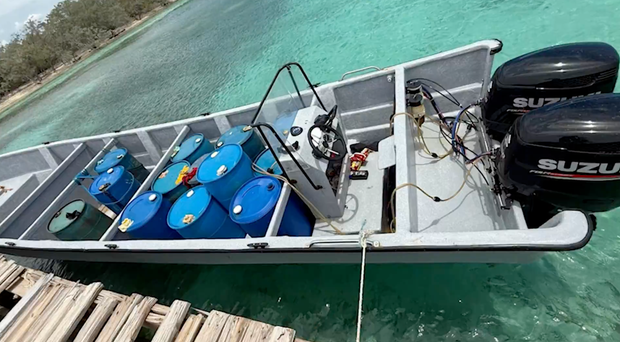
Tropical Storm Gil continues to strengthen in the Pacific Ocean and is expected to reach hurricane status soon, while Iona is expected to remain in tropical storm status before gradually weakening.
In an advisory issued at 11 p.m. Hawaiian Standard Time on Thursday, July 31, the National Hurricane Center said Gil is located about 870 miles southwest of the southern tip of the Baja California peninsula and moving toward the west-northwest.
Gil has maximum sustained winds near 65 mph with higher gusts and further strengthening is forecast, with Gil expected to become a hurricane on Friday, Aug. 1, NHC forecasters said.
Iona, meanwhile, is located about 1,190 miles west-southwest of Honolulu, Hawaii with maximum sustained winds near 45 mph with higher gusts. The storm is moving toward the west-northwest and this motion is expected to continue over the next couple of days with a gradual decrease in forward speed.
“Little change in strength is forecast during the next day or two,” the hurricane center said of Iona, adding that “gradual weakening is forecast to begin on Sunday.”
Tropical Storm Gil path tracker
This forecast track shows the most likely path of the center of the storm. It does not illustrate the full width of the storm or its impacts, and the center of the storm is likely to travel outside the cone up to 33% of the time.
Tropical Storm Gil spaghetti models
This forecast track shows the most likely path of the center of the storm. It does not illustrate the full width of the storm or its impacts, and the center of the storm is likely to travel outside the cone up to 33% of the time.
NHC tracking three other systems brewing in Pacific
The hurricane center said in a July 31 advisory it is also keeping tabs on three other systems in the Pacific Ocean.
The first system is currently a trough of low pressure located about 650 miles south-southest of Hilo, Hawaii, associated with disorganized showers and thunderstorms.
“While the system currently lacks a well-defined low-level center, some development is possible during the next day or so,” the NHC said, however environmental conditions are expected to become less conducive for further development by this weekend. The hurricane center gives the system a 10% chance of formation through the next seven days.
Additionally, an area of low pressure is expected to form well southwest of southwestern Mexico within the next day or two, according to the hurricane center. Environmental conditions appear conducive for some gradual development of this system, and a tropical depression is likely to form late this weekend or early next week as the system moves west-northwestward.
The NHC gives the system an 80% chance of formation through the next seven days.
Lastly, an area of low pressure is forecast to form offshore of the coast of Central America and southern Mexico by the middle part of next week. Thereafter, environmental conditions appear conducive for some development as the system moves west-northwestward. The system has a 20% chance of formation through the next seven days, according to the NHC.
How do hurricanes form?
Hurricanes are born in the tropics, above warm water. Clusters of thunderstorms can develop over the ocean when water temperatures exceed 80 degrees Fahrenheit. If conditions are right, the clusters swirl into a storm known as a tropical wave or tropical depression.
A tropical depression becomes a named tropical storm once its sustained wind speeds reach 39 miles per hour. When its winds reach 74 mph, the storm officially becomes a hurricane.
Prepare now for hurricanes
Delaying potentially life-saving preparations could mean waiting until it’s too late. “Get your disaster supplies while the shelves are still stocked, and get that insurance checkup early, as flood insurance requires a 30-day waiting period,” NOAA recommends.
-
Develop an evacuation plan: If you are at risk from hurricanes, you need an evacuation plan. Now is the time to begin planning where you would go and how you would get there.
-
Assemble disaster supplies: Whether you’re evacuating or sheltering-in-place, you’re going to need supplies not just to get through the storm but for the potentially lengthy aftermath, NOAA said.
-
Get an insurance checkup and document your possessions: Contact your insurance company or agent now and ask for an insurance check-up to make sure you have enough insurance to repair or even replace your home and/or belongings. Remember, home and renters insurance doesn’t cover flooding, so you’ll need a separate policy for it. Flood insurance is available through your company, agent, or the National Flood Insurance Program. Act now, as flood insurance requires a 30-day waiting period.
-
Create a family communication plan: NOAA said to take the time now to write down your hurricane plan, and share it with your family. Determine family meeting places, and make sure to include an out-of-town location in case of evacuation.
-
Strengthen your home: Now is the time to improve your home’s ability to withstand hurricane impacts. Trim trees; install storm shutters, accordion shutters, and/or impact glass; seal outside wall openings.
Gabe Hauari is a national trending news reporter at USA TODAY. You can follow him on X @GabeHauari or email him at Gdhauari@gannett.com.
This article originally appeared on USA TODAY: Tropical Storm Gil tracker, path: Storm expected to become hurricane



